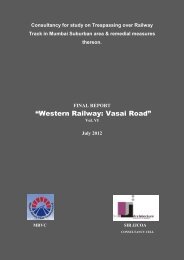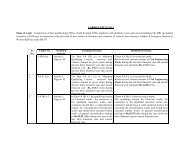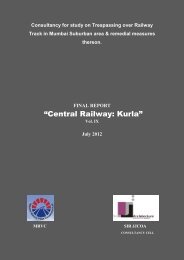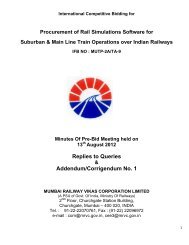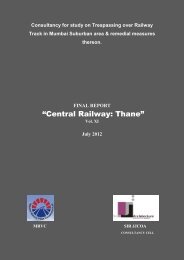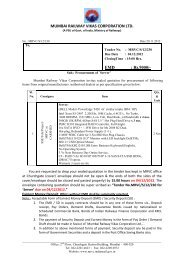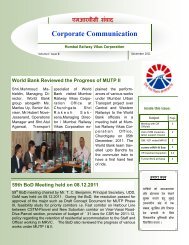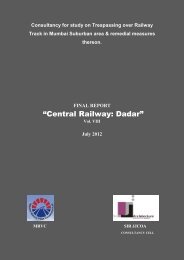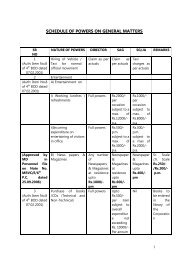World Bank Document - Mumbai Railway Vikas Corporation Ltd ...
World Bank Document - Mumbai Railway Vikas Corporation Ltd ...
World Bank Document - Mumbai Railway Vikas Corporation Ltd ...
Create successful ePaper yourself
Turn your PDF publications into a flip-book with our unique Google optimized e-Paper software.
capacity. The component also supports studies and technical assistance, among other things, to<br />
improve Indian <strong>Railway</strong>s capabilities for track and rolling stock maintenance, financial<br />
management and control systems, railway safety and quality assurance.<br />
99. Since its start the project has made significant progress towards achieving its<br />
development objectives. As a result of the resettlement of squatters along rail tracks and the<br />
completion of track doubling on the Western <strong>Railway</strong> corridor, the efficiency of suburban train<br />
operations has increased, with a rise in its peak-time capacity by 7-10 percent and a reduction in<br />
commuting time by four to nine minutes for about six million daily passengers. An improvement<br />
in transport services in terms of quality and comfort is noticed as a result of the addition of a few<br />
new trains and the replacement of 644 buses by new ones. However, improvements in traffic<br />
management technical capacity within the Municipal <strong>Corporation</strong> of Greater <strong>Mumbai</strong> need to be<br />
further strengthened and sustained.<br />
100. Up to March 2010, 84 twelve-car rakes of new EMU trains (equivalent to 108<br />
nine-car rakes) were put into service. Of these 84 rakes, 51 were financed by the <strong>Bank</strong> and<br />
procured by MRVC, while the other 33 rakes were funded and procured by Indian <strong>Railway</strong>s on<br />
their own. Together, they have reduced crowding in the system from 500 people per coach ppdpk<br />
to 450, despite a net increase in passengers. It is expected that once all additional 72 <strong>Bank</strong>financed<br />
twelve-car trains (equivalent to 96 nine-car trains) are in service, crowding will be<br />
reduced to 350 ppdpk, i.e. 30 percent less than the original density --but still twice the rated<br />
carrying capacity.<br />
101. Through the preparation of MUTP-1 a partnership was created between the GOM<br />
and IR for developing <strong>Mumbai</strong>’s suburban rail system, and it was institutionalized by the<br />
creation of MRVC. MRVC as an implementing agency has proven to be an efficient tool, and<br />
attests to the success of this partnership. Prior to MUTP-1 the <strong>Mumbai</strong> suburban system suffered<br />
due to lack of investment in renewal of aging assets as well as expansion to meet the everincreasing<br />
demand, as IR had much greater interest in main line services on a national scale. The<br />
partnership between GOM and IR has been considered positive enough to continue for the<br />
preparation and implementation of MUTP-2A. And MRVC has gained professionalism in project<br />
implementation, coordinating effectively with both the GOM and the various departments of IR.<br />
Its increased efficiency has resulted in MRVC being commissioned for other studies to develop<br />
suburban rail services in <strong>Mumbai</strong>.<br />
102. Through MUTP-1 MMRDA has gained experience and capacity in handling<br />
resettlement of large numbers of people. This project has been a first for <strong>Mumbai</strong> and a first for<br />
the <strong>Bank</strong> to handle resettlement of so many people in an urban setting. During implementation,<br />
difficulties occurred in handling the resettlement. A <strong>World</strong> <strong>Bank</strong> Inspection Panel investigated<br />
the project’s resettlement process and raised concerns about implementation issues, including the<br />
way medium and large shopkeepers were resettled, the quality of the baseline survey of projectaffected<br />
people, management of post-resettlement activities, grievance redressal processes, and<br />
project supervision. The implementation by GOM of a remedial action plan, with the active<br />
support of the <strong>Bank</strong>, resulted in a much improved quality of the resettlement and rehabilitation<br />
process. MMRDA evolved towards a problem-solving approach for resettlement, exploring<br />
negotiated solutions as often as possible. The experience gained by MMRDA thereby is now<br />
used by the <strong>Bank</strong> as an example for other large cities with similar challenges.<br />
28





